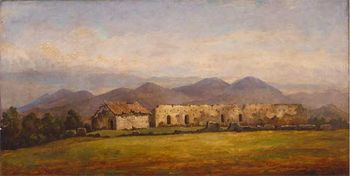Santa Margarita de Cortona Asistencia
| This article is part of a series on the Spanish missions in California  The Santa Margarita de Cortona Asistencia, 1881.[1] | |
| HISTORY | |
|---|---|
| Location: | Santa Margarita, California |
| Coordinates: | 35° 24′ 2″ N, 120° 36′ 44″ W |
| Name as Founded: | Asistencia de la Misión de San Luis, Obispo de Tolosa [2] |
| English Translation: | Attendant to the Mission San Luis Obispo de Tolosa |
| Patron Saint: | Saint Margaret of Lavinio and Cortona, Italy [3] |
| Nickname(s): | "San Luis Obispo County's Third Mission" |
| Founding Date: | 1787 [2] |
| Military District: | Third |
| Native Tribe(s): Spanish Name(s): |
Chumash Obispeño |
| Primordial Place Name(s): | Trolole [4] |
| DISPOSITION | |
| Secularized: | 1835 |
| Caretaker: | Private entity |
| Current Use: | Non-extant |
| California Historical Landmark: | #364 |
The Santa Margarita de Cortona Asistencia is a former religious outpost established by Spanish colonists on the west coast of North America in the present-day State of California. Founded in 1787 on a site originally selected by Father Presidente Junípero Serra in 1772, the settlement served as an asistencia ("sub-mission") to nearby Mission San Luis Obispo de Tolosa. Named after an Italian penitent of the Third Order of Saint Francis, the settlement was located at the top of the Cuesta Grade (north of the present-day City of San Luis Obispo). Designated as a California Historical Landmark, the facility also served as a visita (country chapel) and storehouse.
History
Santa Margarita de Cortona was established to minister to the large number of Chumash Indians who inhabited the area. A building measuring some 120 by 20 feet served as the chapel and also contained eight auxiliary rooms for the use of the majordomo and his servants, as well as quarters for visiting priests. One chamber functioned as a granary for storing mission crops in support of the extensive grain cultivation conducted at the site. On November 20, 1818 the French privateer Hipólito Bouchard raided the Presidio of Monterey and threatened the nearby Mission San Carlos Borromeo de Carmelo; accordingly, many of the mission residents sought refuge at this site. The Santa Margarita Asistencia was secularized along with Mission San Luis Obispo in 1835, and suffered the same neglect that many mission properties did after that time. In 1841 the lands, encompassing over 17,000 acres (69 km²), were granted to Joaquin Estrada. After the American takeover at Monterey in 1841, General Pío Pico and General José Castro met at the rancho to discuss strategy. During the 1846 Bear Flag Revolt, the forces of Captain John C. Frémont captured an Indian bearing a message from Jose Jesus Pico (the San Luis Obispo Justice of the Peace) at the rancho and ordered his execution. In December of that year Frémont also arrested Estrada and others at the rancho, releasing them only after securing their pledges of service to Frémont.
The Public Land Commission issued a patent for the rancho in April, 1861 to Martin and Mary Murphy of San Jose. That property (and others) ultimately passed along to their son Patrick Murphy, who served in the California Assembly and the California State Senate for three terms. Eventually Assemblyman Murphy amassed holdings of over 70,000 acres (283 km²) statewide. General P. W. Murphy acquired the property in the 1860s and erected a barn over the adobe structure to shield it from the elements. In February, 1889 the town of Santa Margarita was incorporated. Today the former rancho lands (operating as the "Santa Margarita Ranch") are under the collective ownership of three families. Several of the original stone walls remain standing, having been incorporated into a barn.